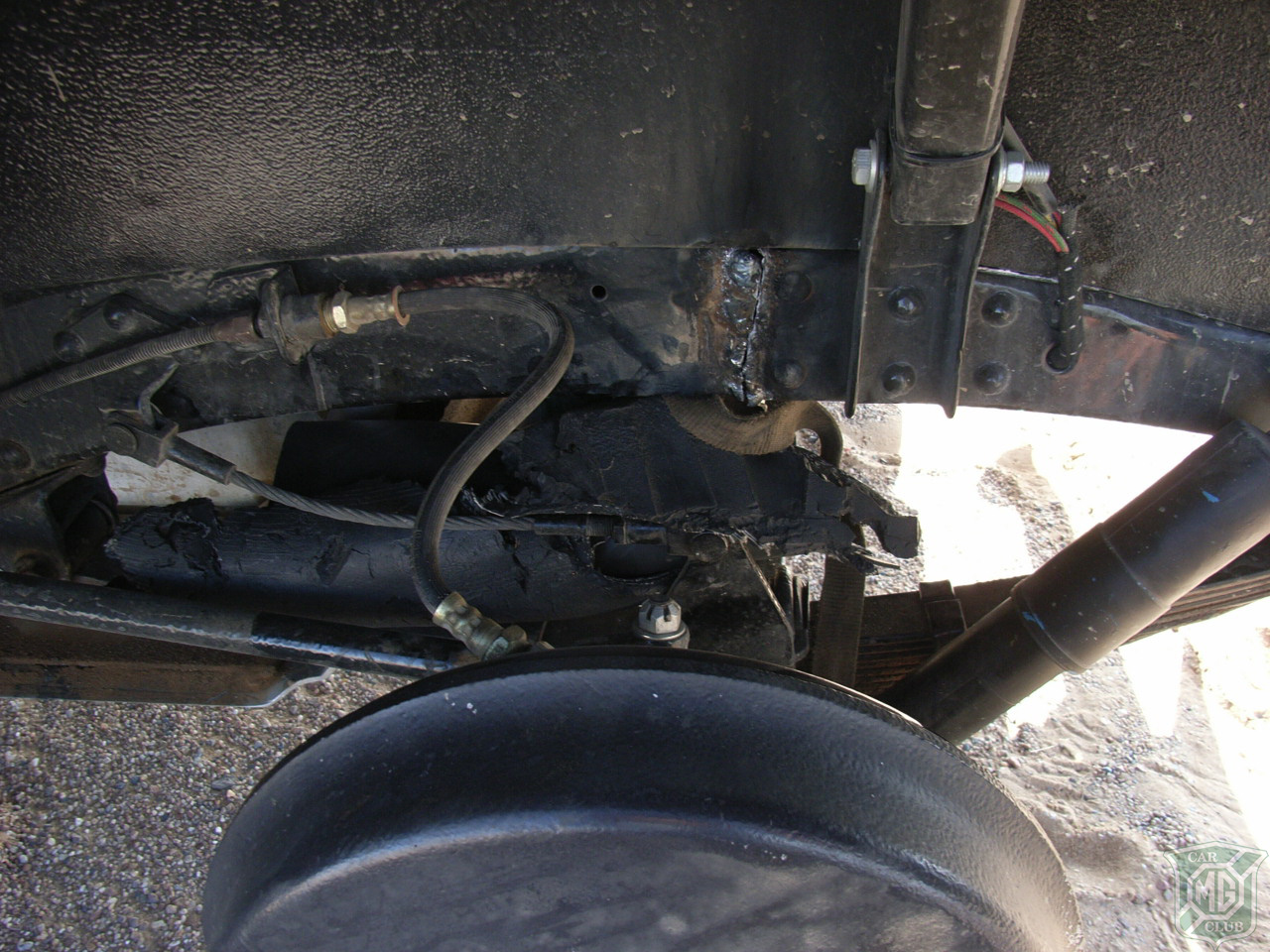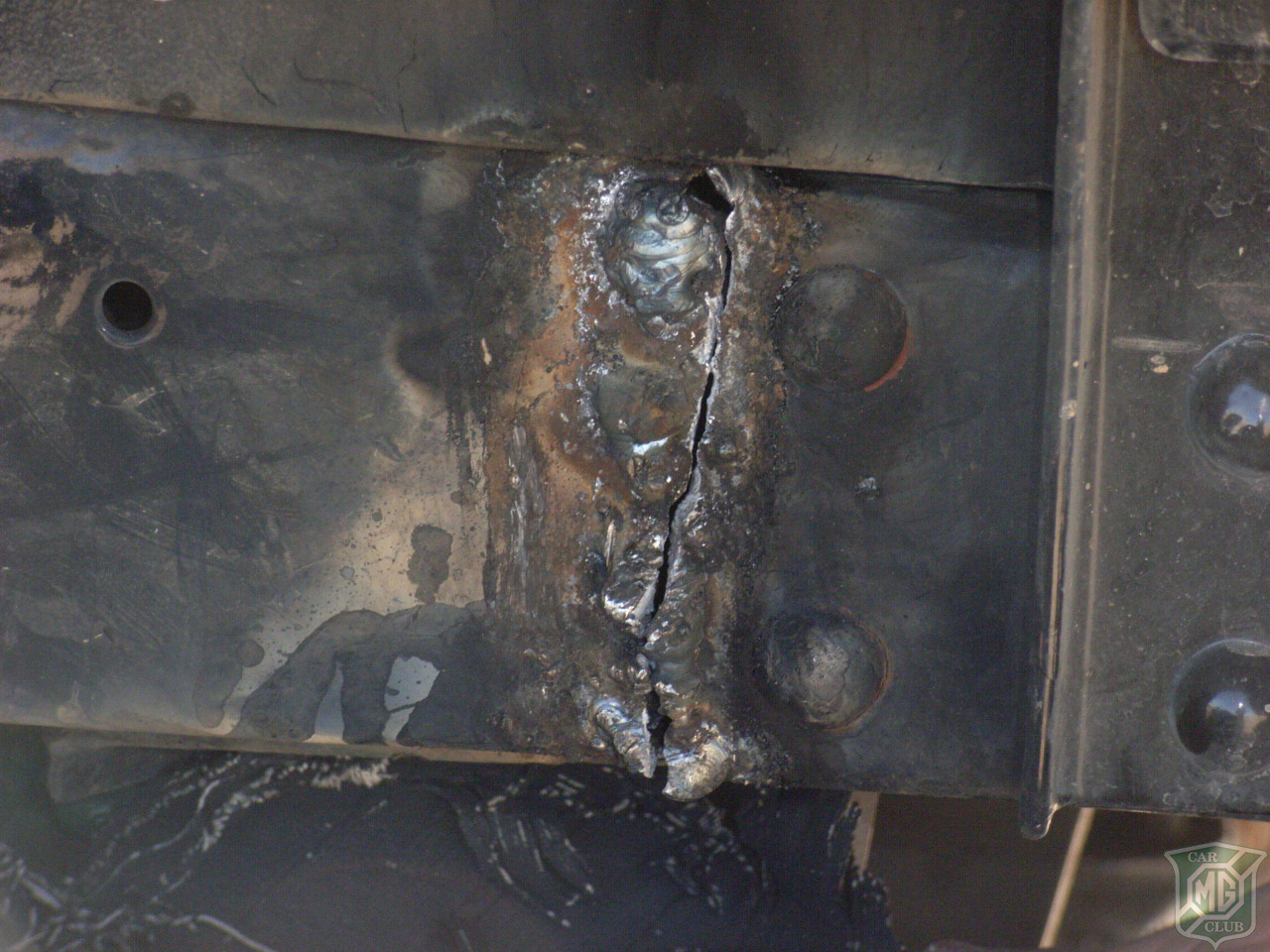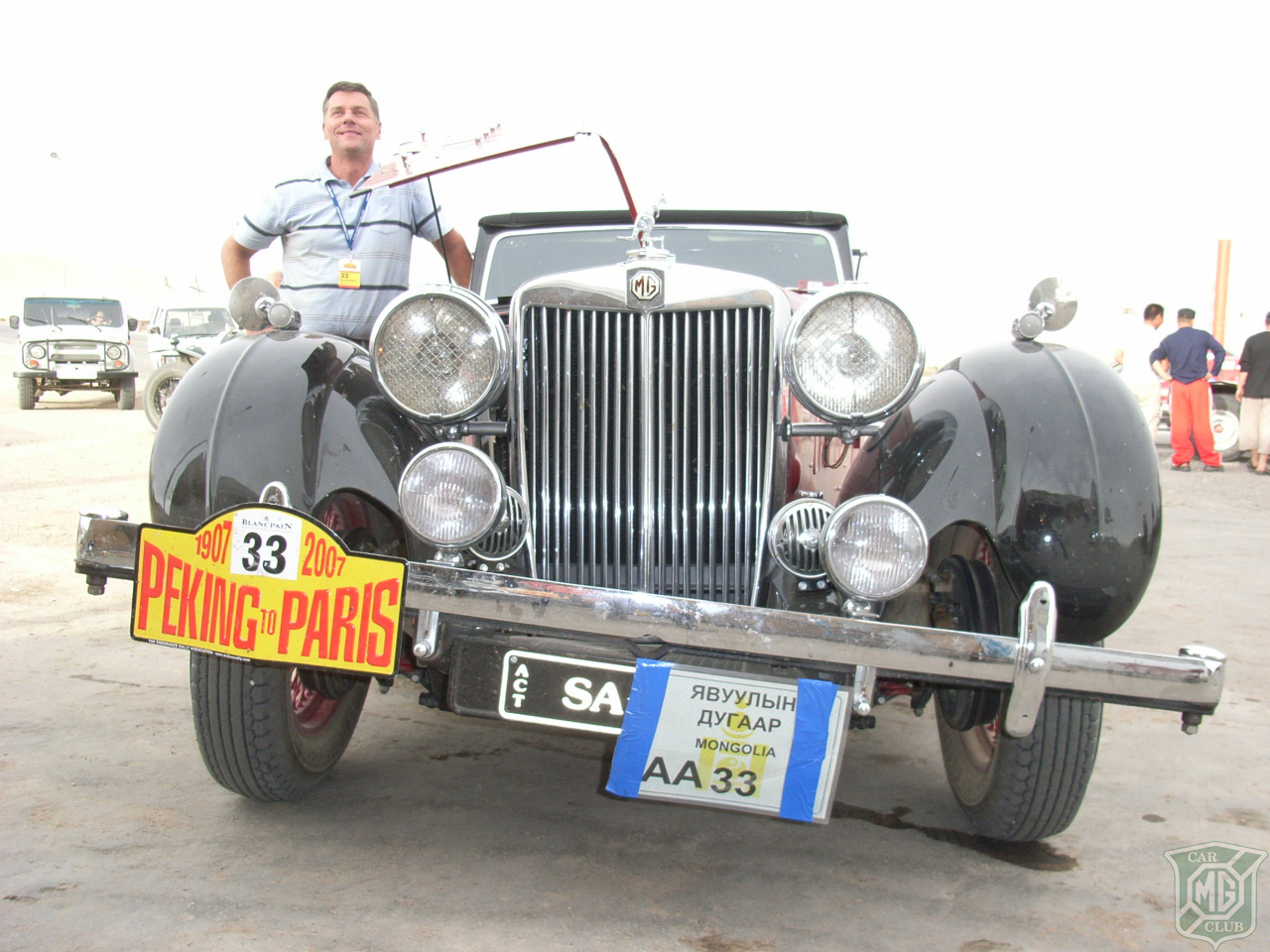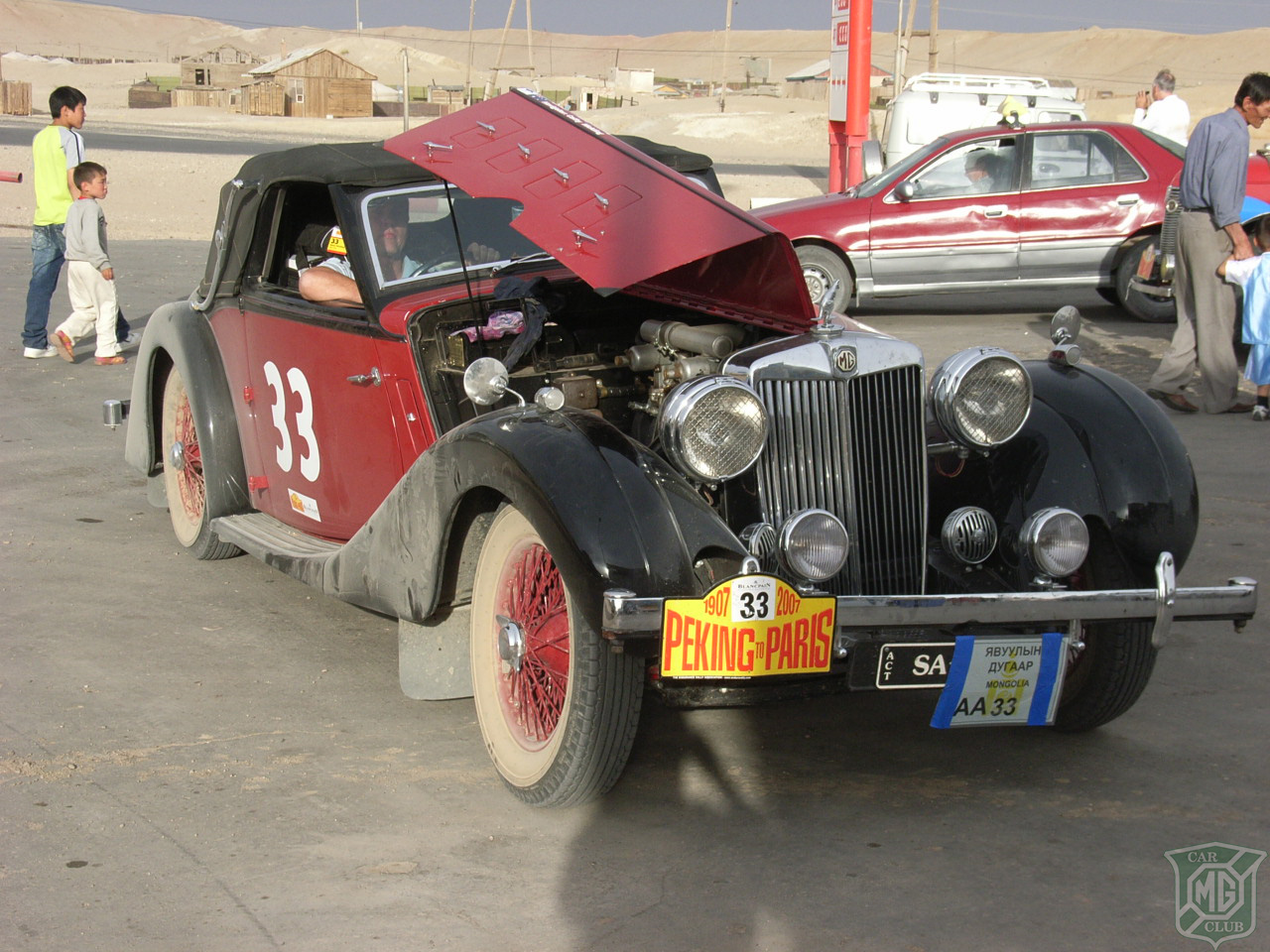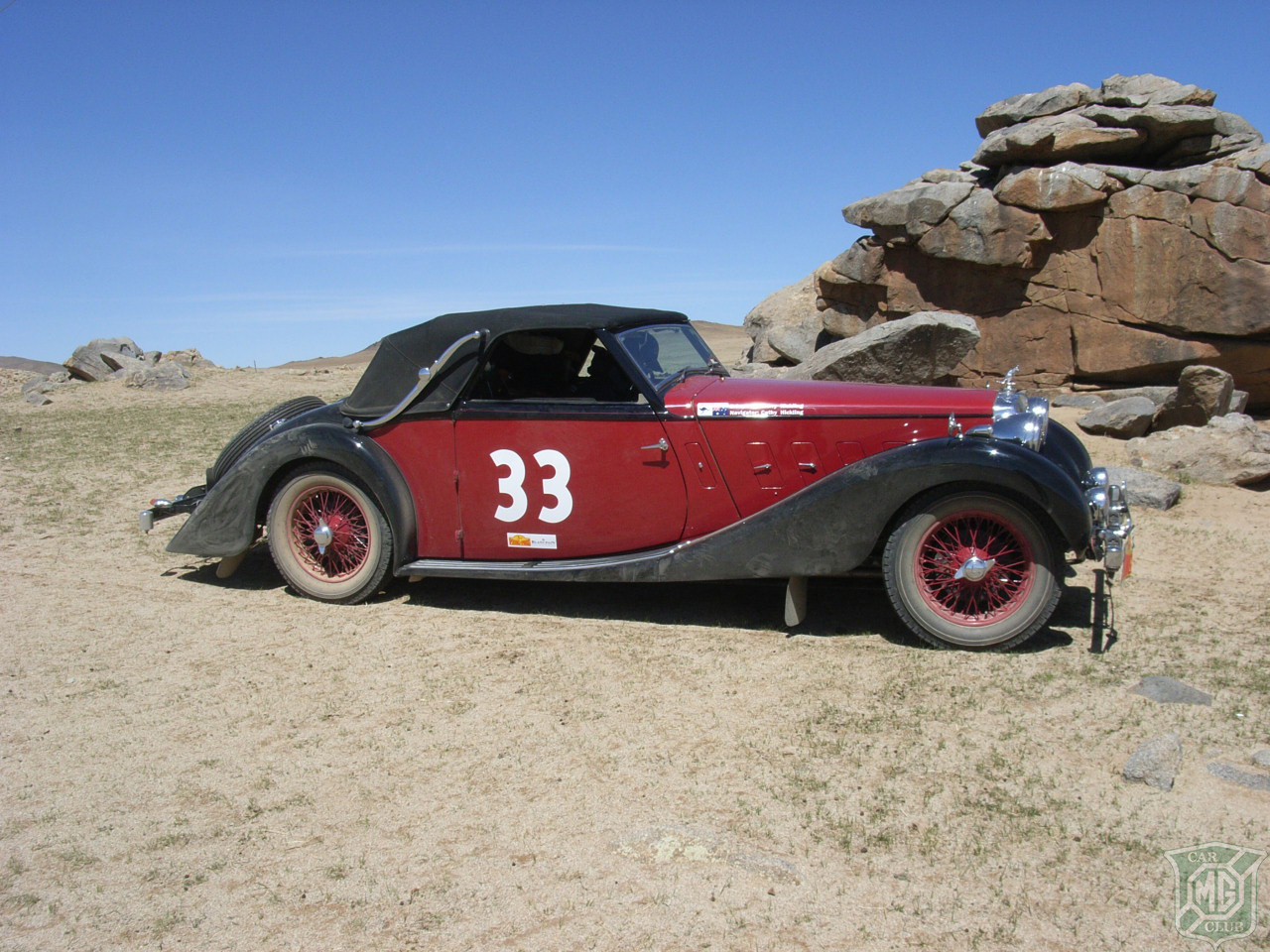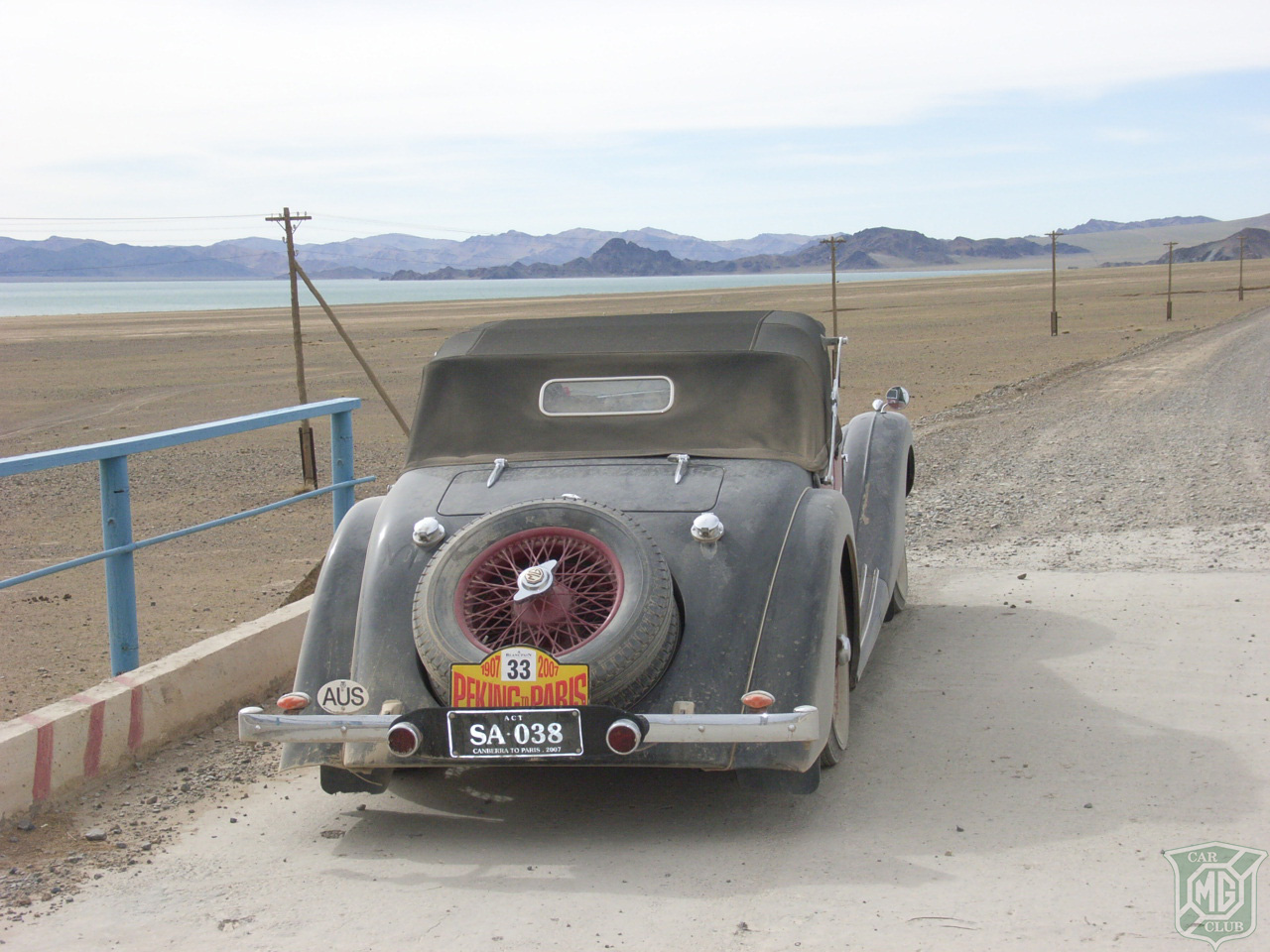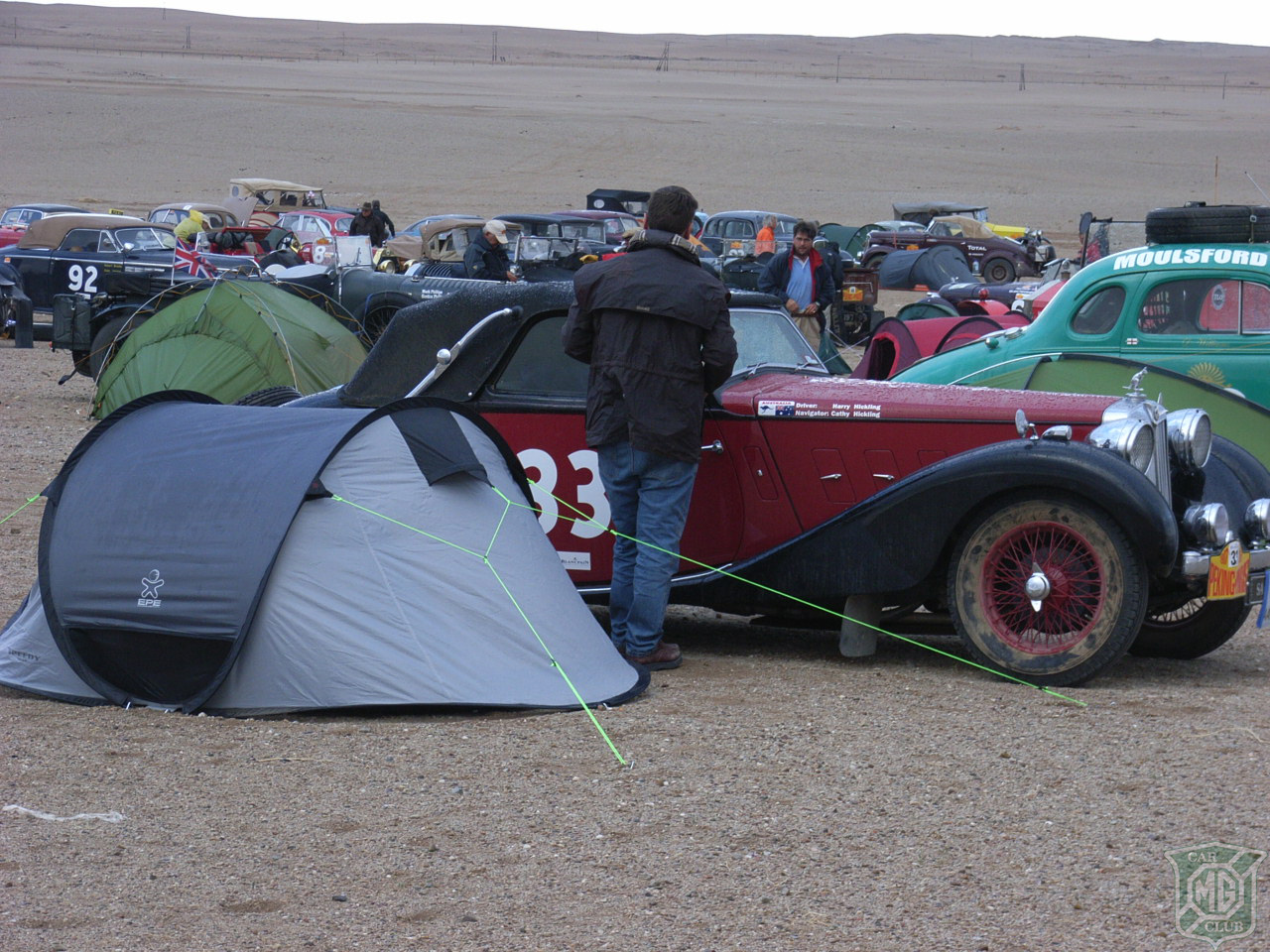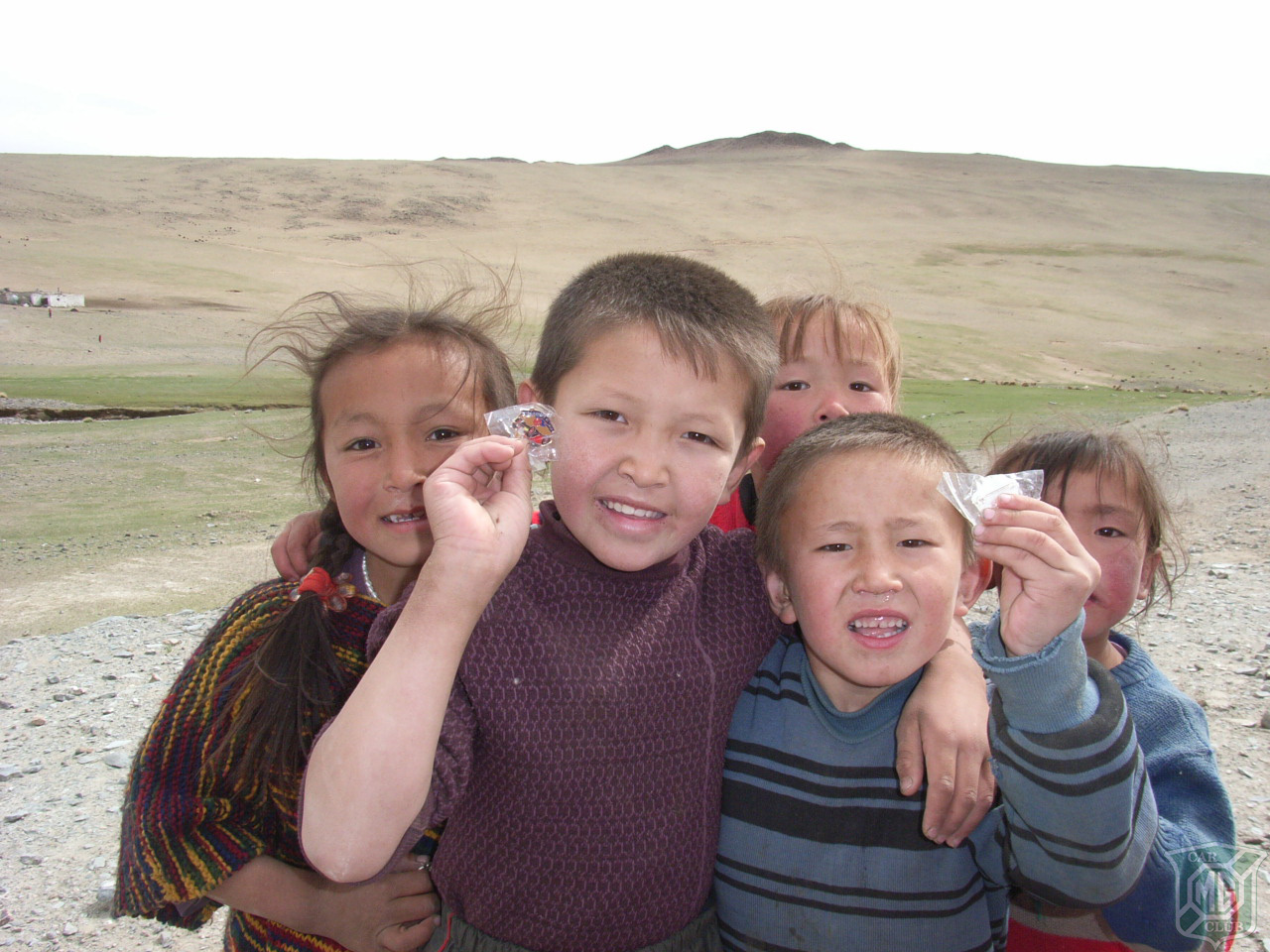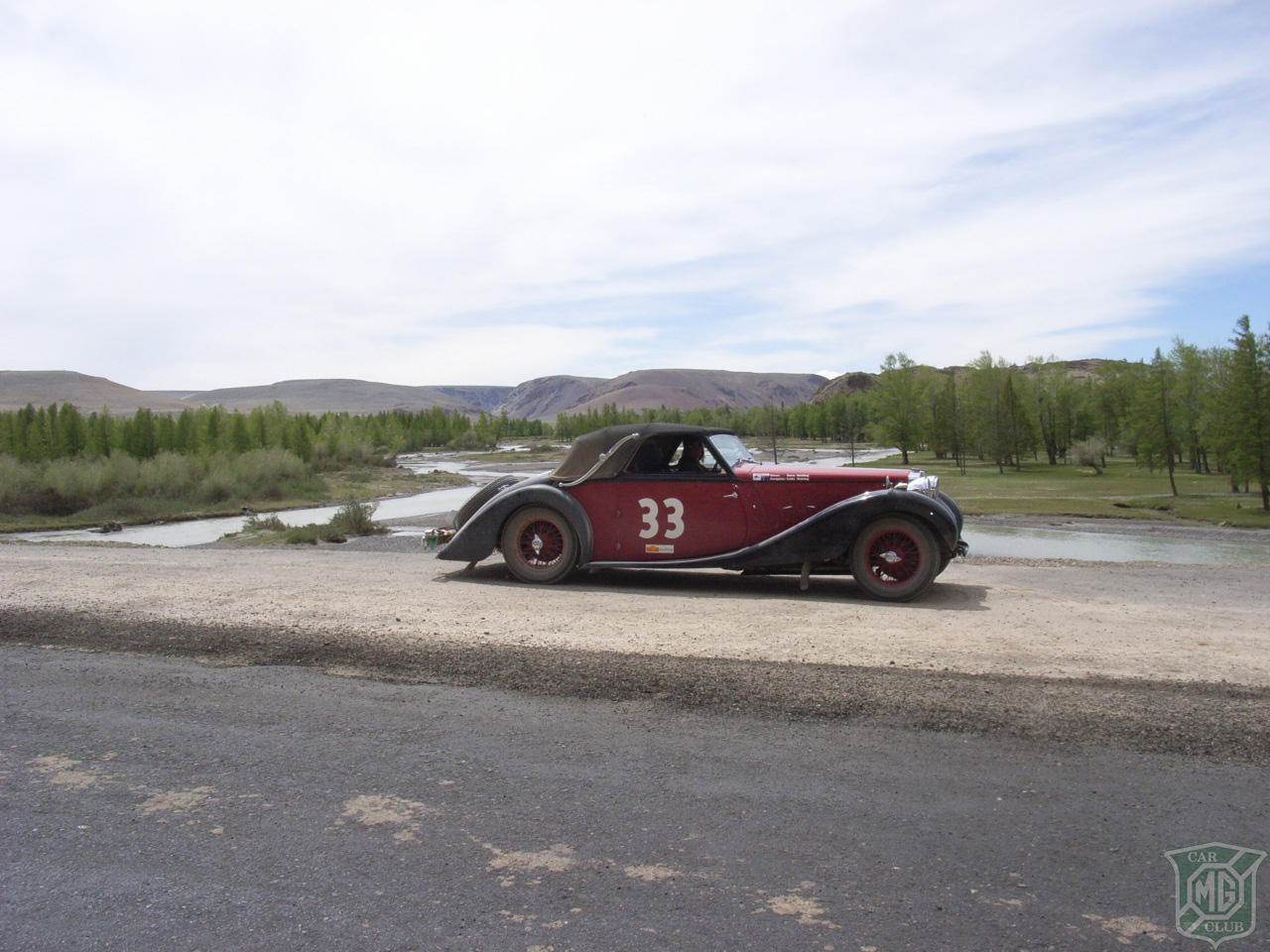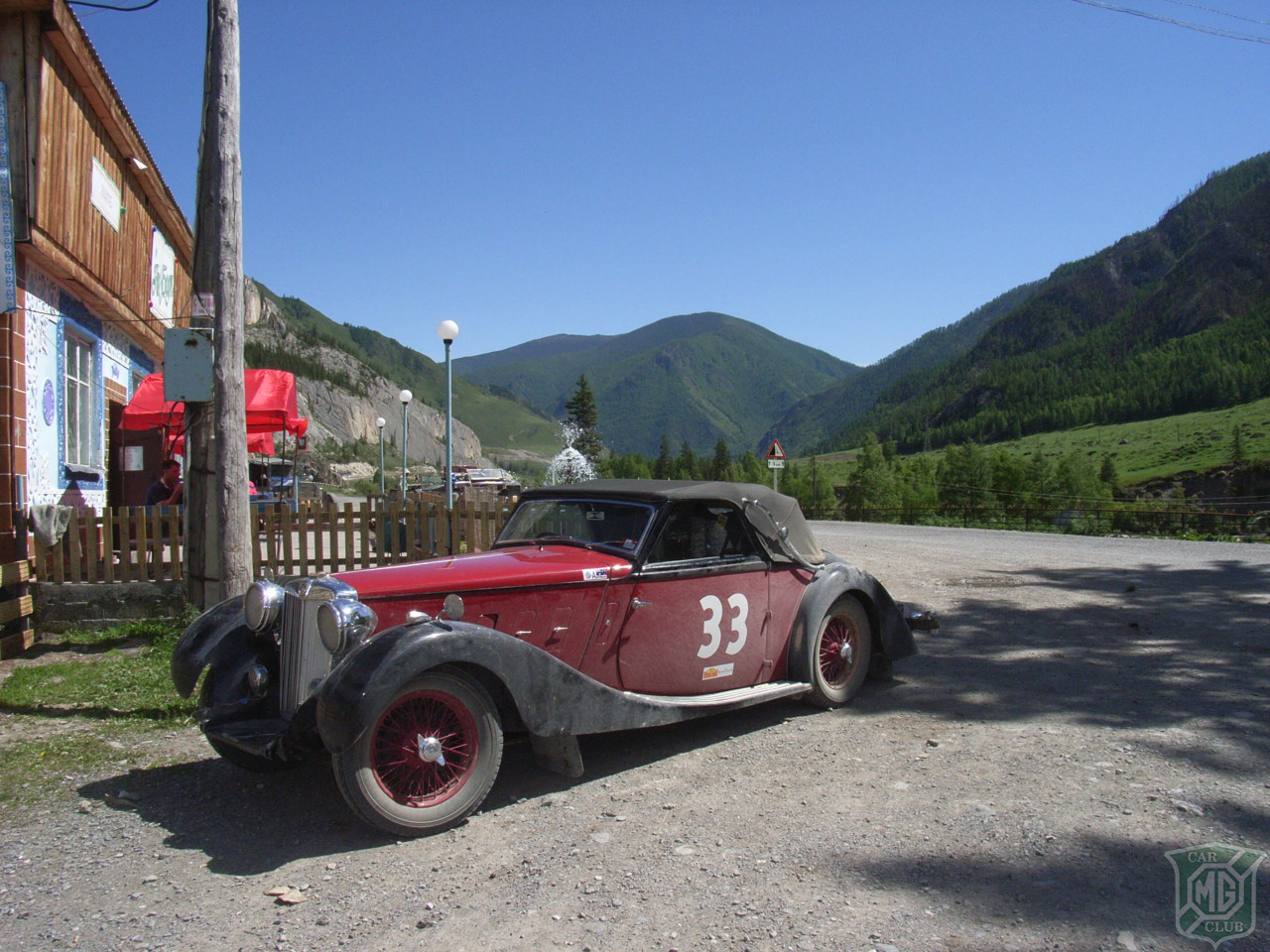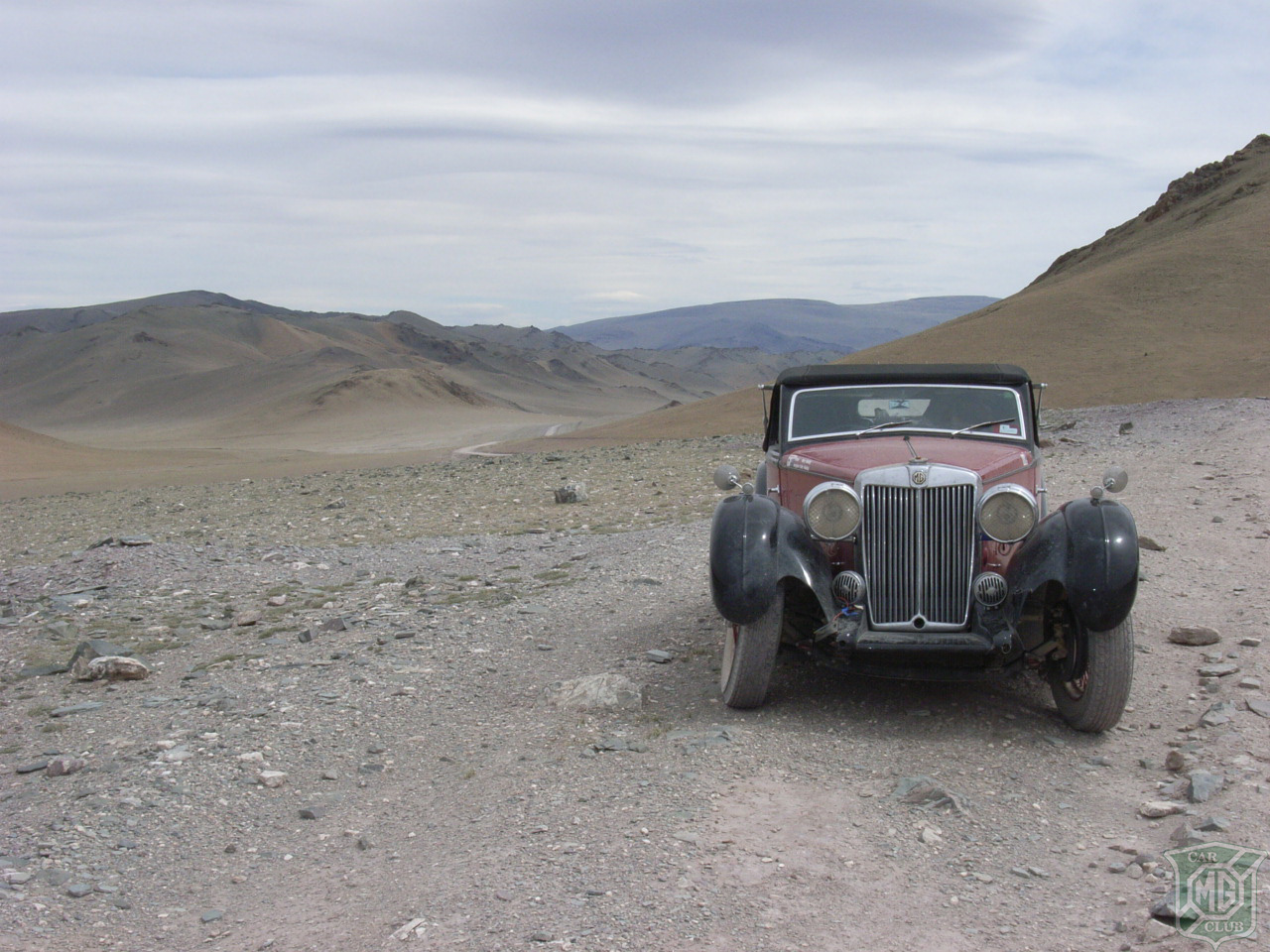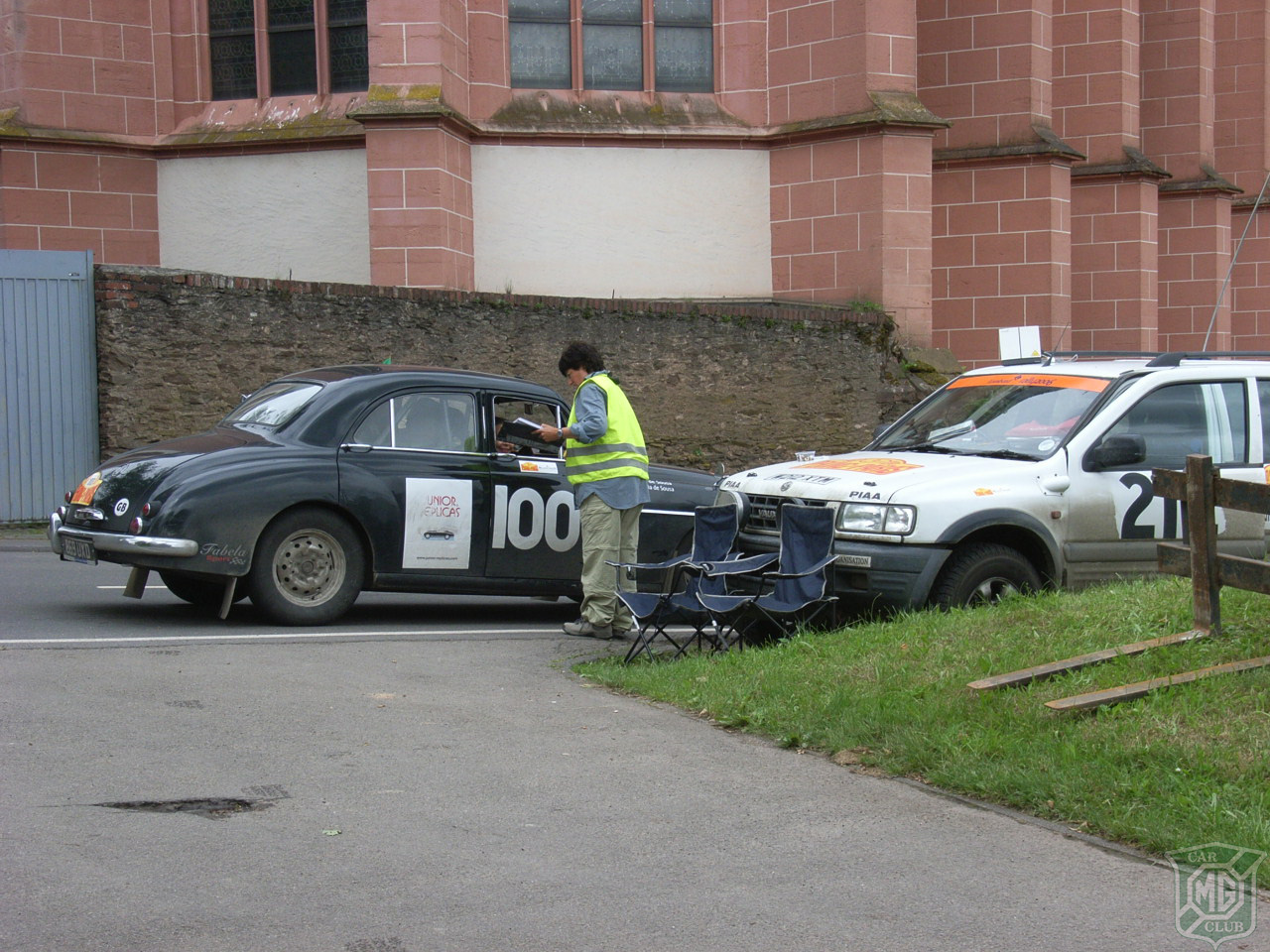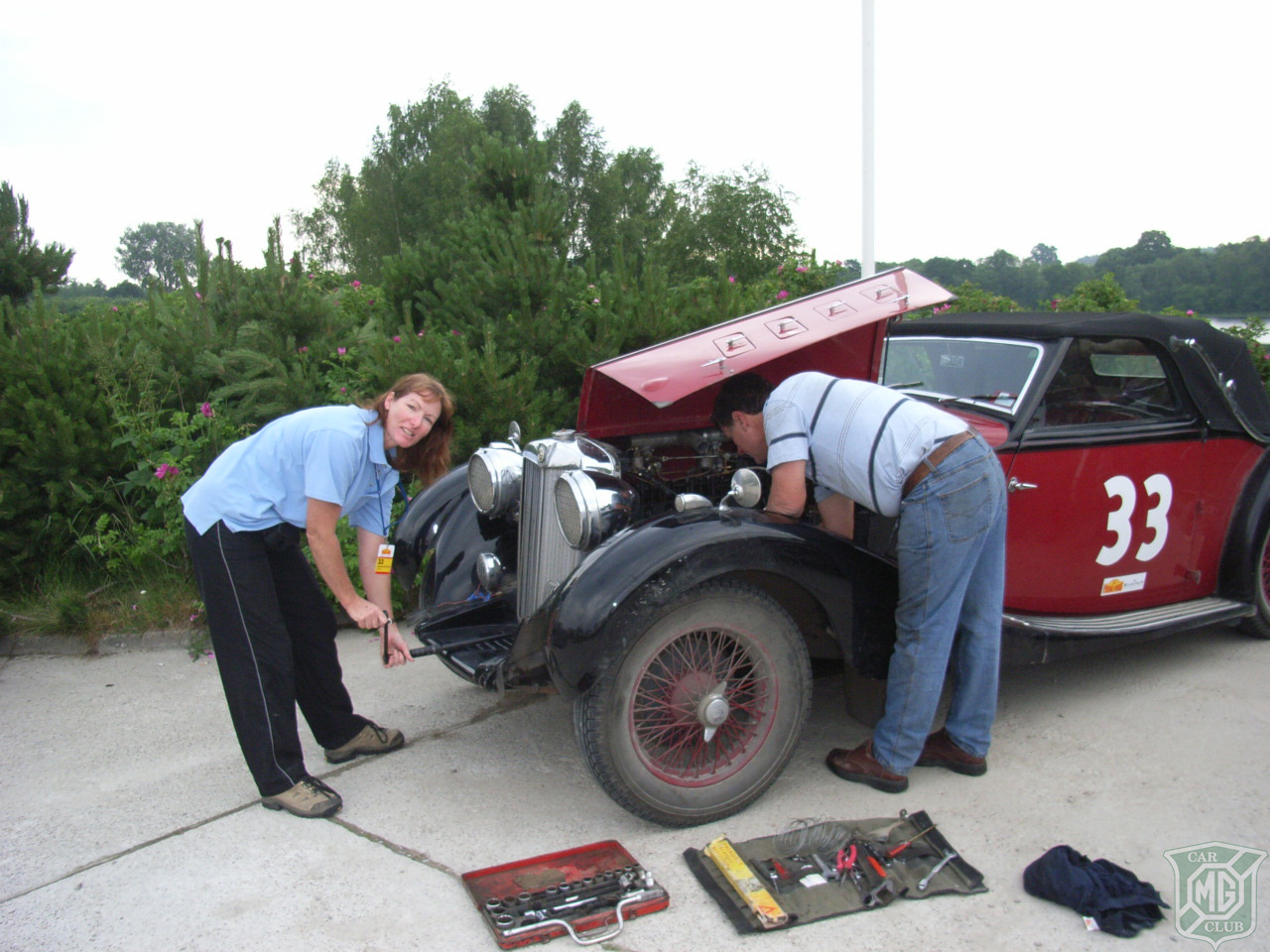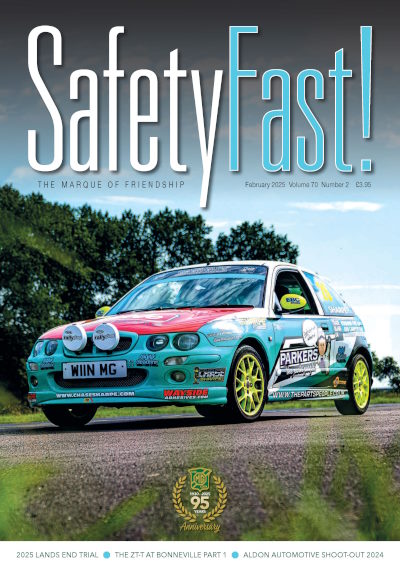Reproduction in whole or in part of any article published on this website is prohibited without written permission of The MG Car Club.
2007 Peking to Paris rally in a 1938 MG SA
The original Peking to Paris Rally saw our early motoring pioneers take up the Challenge of who would be first to travel across the world from Peking to Paris. A trip of 1500 kms across the world with no roads the five teams had to forge their way across the Northern China, Gobi, Siberia, and Europe. Of course Prince Borghese in the 7422cc Itala was clearly best prepared for the Rally and even took a detour to St Petersburg for a dinner.
The 2007 event has been the first time in 100 years that a Rally could be re-run across this route. In 1907 no MG was available to take on the challenge. It was run by DeDions, the Itala, a Spiker and a three wheeler Contal. Unfortunately the Contal, never made it across the Gobi. In 2007 two MG’s took up the challenge. The 1938 MG SA of Harry and Cathy Hickling from Australia and a 1958 ZA Magnette driven by Jose and Maria Romao De Sousa from Portugal.
The first ever MGs to travel across the world from Australia to Paris arrived with cameras flashing and welcoming reception. As always the Australian Kangaroo Mascot sits proudly on the MG SA radiator cap. This must be the most photographed mascot in the world winning the hearts of people in China, Mongolia, Siberia, Russia, Europe and finally Paris, France. The mascot of course announces that this car is from Australia on the 100th anniversary of the original Peking to Paris Rally.
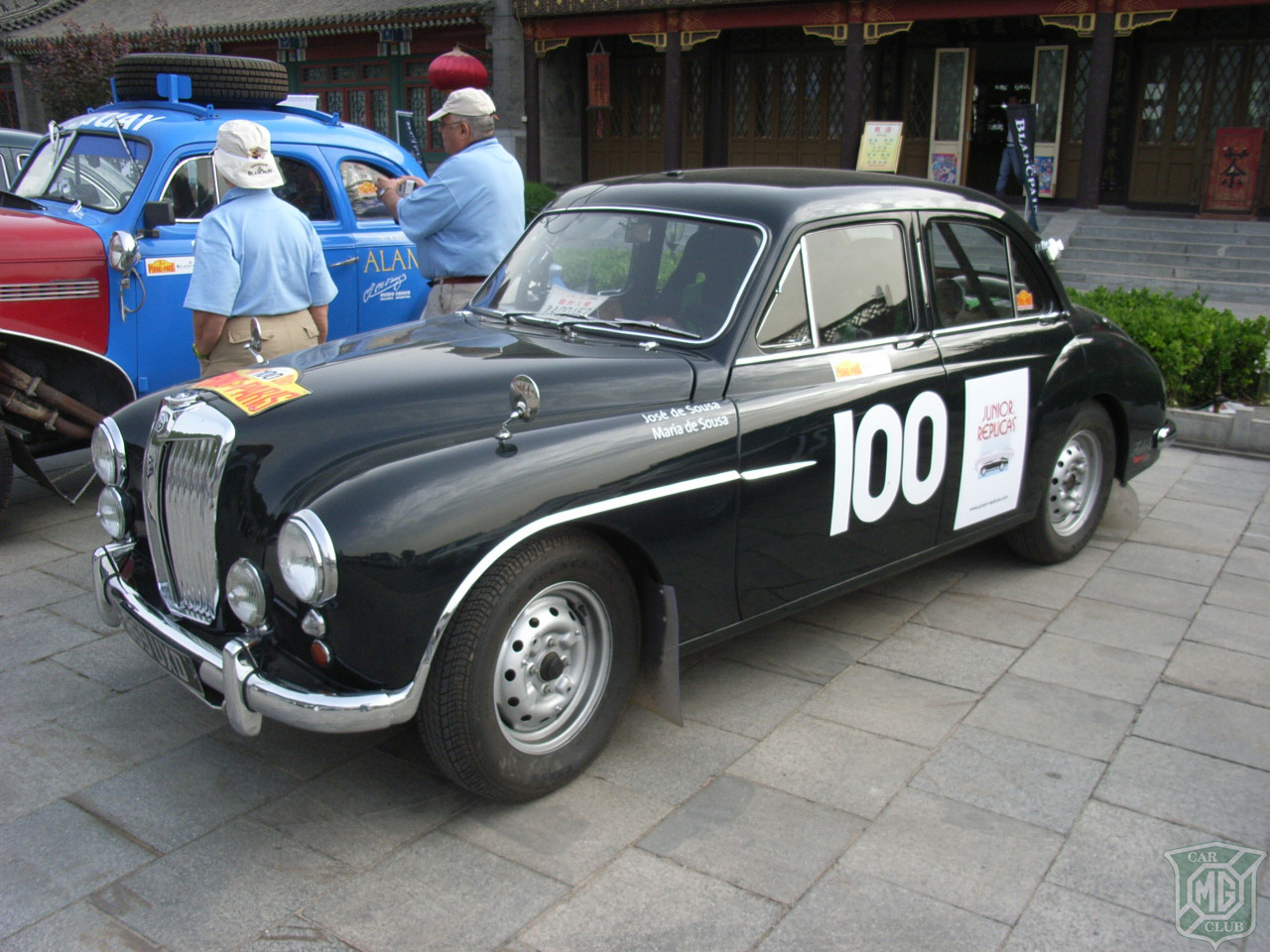
A two seater SA Keller Replica and rally car (SA 2337)
This is an epic journey. The MGs have survived 15,000 kms (9321 miles) of the worst roads on earth. The MG is a 1938 MG SA that is basically of standard specification but purposely prepared for the Rally. The car has fitted two separate fuel systems with independent fuel pumps, filters, lines and Long Range fuel tanks of 50 litres each. The car also had uprated springs with additional secondary main springs. Similar to a 4WD, if the main spring breaks the car can continue to the next rally stop for repairs.
Careful consideration was also give to detailed items such as a pressurised cooling system with header tank mounted on the firewall, carefully prepared exhaust system and two independent batteries. Other rally essentials, including Halda distance measuring equipment. Harry continues: “One of the most essential items fitted to the car was the high strength Alloy sump guard. This took a huge battering and without it the car would have been knocked out even before we reached Mongolia”.
As you can see from the accompanying photographs, the rally MG carries an elegant two door drophead coupe coachwork. The car was built as a Keller replica and with the support of Peter Ratcliffe from SVW spares in England the car is a spectacular recreation of these original cars. “I have always admired these beautiful cars, and I always had in mind that one day the SA wreck in the back of the garage would be turned into a Keller replica. The rally allowed me to do this. So the car has a dual personality.
On one side it is a faithful replica of a two seater SA Keller and on the other side it is a tough Rally Car that has proved well capable of travelling across the toughest roads on earth”. Harry continues: “Peter was instrumental in helping us with the car. I had spent many hours getting the lines correct and reverse engineering the original photo’s that I have collected. Peter, however with his practical experience took our work an extra level. He also built for us that ever important three position drophead hood mechanism and provided for us many of the parts that we were missing for the car”.
The car is painted in the original MG colours of Saratoga Red and Black, and is otherwise or very original specifications. Even the boot lid hinges are in fact NB Magnette Door hinges. “People around the world regarded the car as being the most attractive of all the rally cars. They admired those lovely SA lines, the dash panel and instruments, MG badges and of course the lovely Kangaroo mascot”.
Incredibly the car was restored and rally prepared in a little over eighteen months with a strict deadline for registration and shipment to China. As a result the actual testing time for the car was limited to only three test runs. Each revealing issues that needed to be fixed including: fuel pumps that failed in the heat of the Australian summer, a failed head gasket and manifold gasket, and finally poor brakes.
A test of endurance
Harry and Cathy drove the SA the whole way when many fell behind or were shipped on trucks. Their journey tells the story of just how tough driving from Peking to Paris really is.
The front right hand of the Chassis was broken on the first day of the Gobi desert and despite being welded that night was broken again within 5 kms of the Camp. As a result the car was driven for two days across the Gobi with a broken Chassis. The axle being hard up against the Chassis was bent and twisted. The Chassis was repaired in Ulaan Bataar. But the car was driven with a badly bent axle until Novosibirsk Siberia, some 3,500 kms.
The Front Shock absorbers, probably the source of the broken Chassis where removed in Ulaan Bataar. The rears, broken and unrepairable from Altay to Paris.
At Altay the head gasket was repaired twice and the car nearly sent home to Australia after the engine side cover plate worked loose on the corrugated roads.
The front Bumper Bar sheared off and was lost to the Mongolian Desert. Horn mounts, badge bar, and radiator support mounts all broken after days of the toughest roads in the World. Even the fuel bowl fell off, stripping the thread and taking over 3 hours to repair in the middle of the Desert. It was that rough! The front Left Chassis was broken and repaired at Khovd.
And just when Harry and Cathy must have felt relief in arriving within Europe they had to drive the final 2,300 kms from Estonia on five Cylinders with a broken Cam Follow.
No wonder Cathy is so pleased to have crossed the finishing line in Paris, proudly holding out the Bronze finishing medal for the Camera.
China
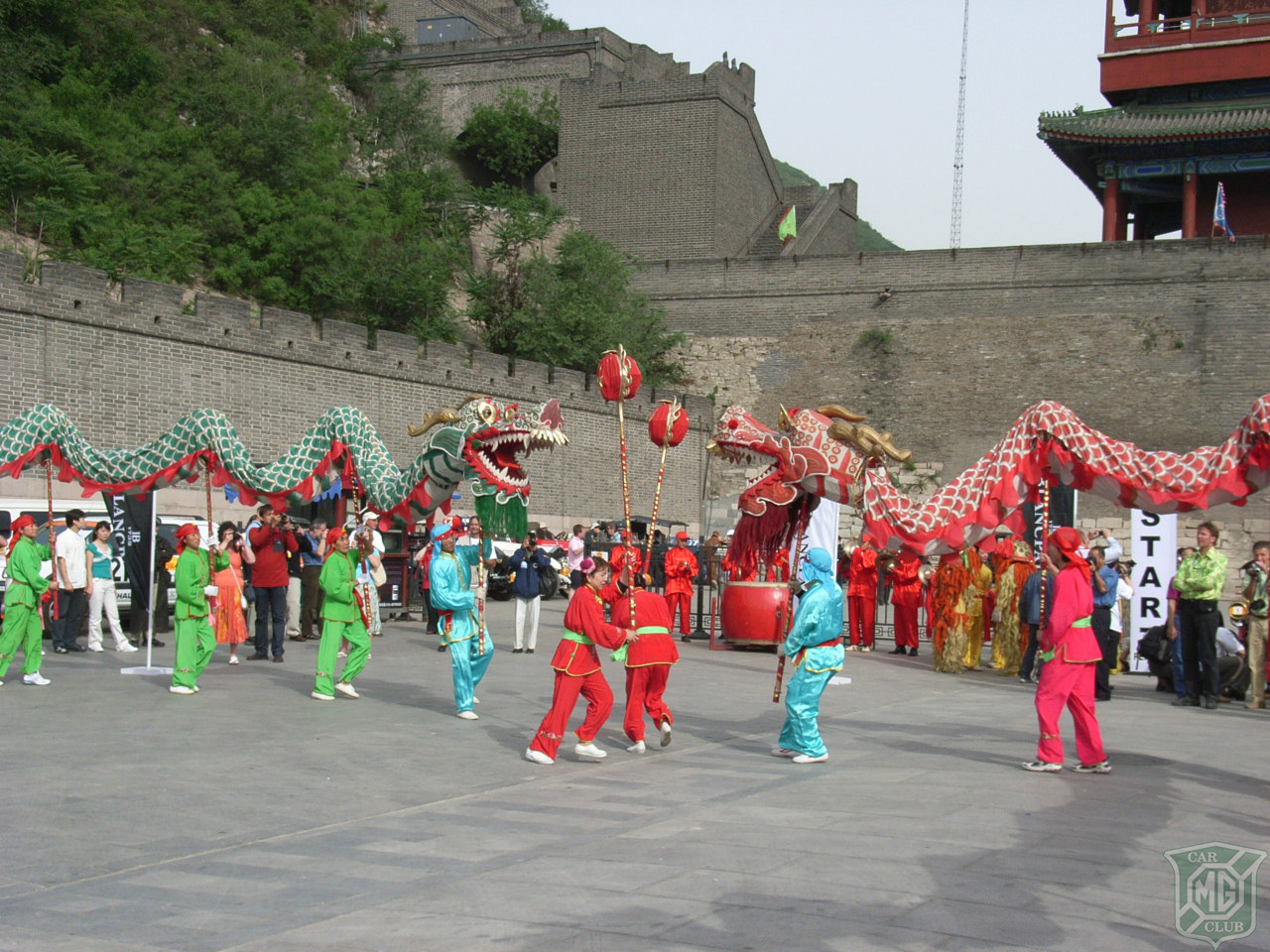
The rally left from the Great Wall of China on Sunday May 27th and the Chinese hosted a colourful farewell with a traditional Chinese Ceremony. The cars are flagged off in one minute intervals. With Chinese Licence and Registration in hand the MG joins the freeway heading north towards the Gobi. The trucks and the traffic, even at 7:30 in the morning, are chaotic. No road rules seem to exist here, but the Chinese politely make way for the MG as it carves it way through the traffic. The traffic soon fades away as the rally drives into Northern China, through mud villages that have not yet been caught up by the march of modernisation. The landscape also dramatically changes into Grasslands and now Donkey and Cart are as common as cars for transport. The roads quickly deteriorate into rough stony roads with the cars having to navigate several creeks and dry river bed crossings.
Here the MG passes its first test of being able to scale the embankments. Harry explains that “The Italia and the LaFrance are far better suited to this with their high ground clearance. You can see the massive torque of the LaFrance as it climbs out of the crossings. The MGs long low Chassis and rear guards where always a concern. However, we only got stuck once, with the rear wheels hanging and the weight of the car resting on the rear guards. And then we had a dozen Chinese stop and help man handle the car back onto the road”. China took its toll on the Rally with serious break downs all the way back to the Great Wall of China were the Knox broke No 4 cylinder casting. Incredibly this open car was trucked to Northern China and drove to Paris on 3 cylinders.
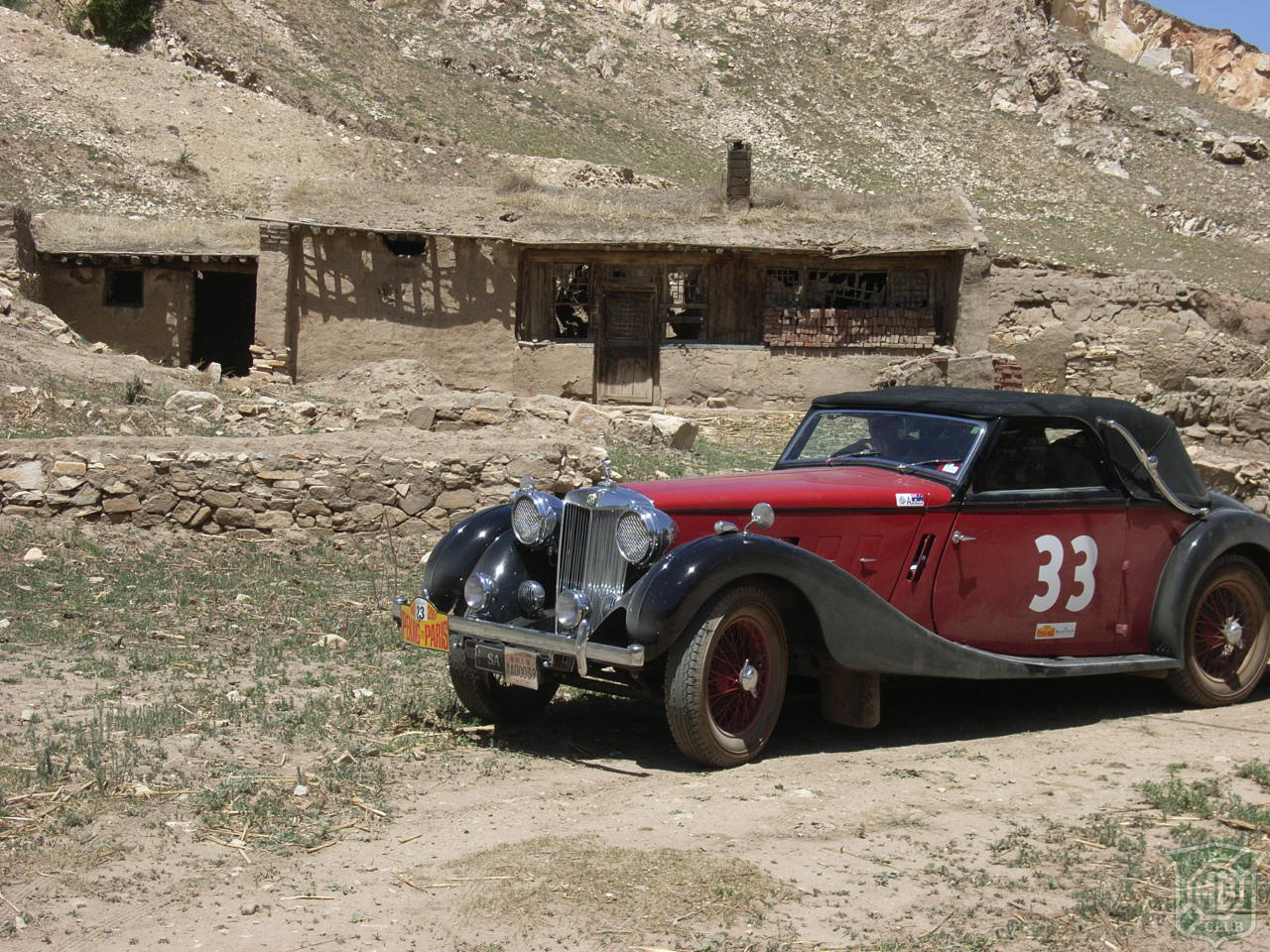
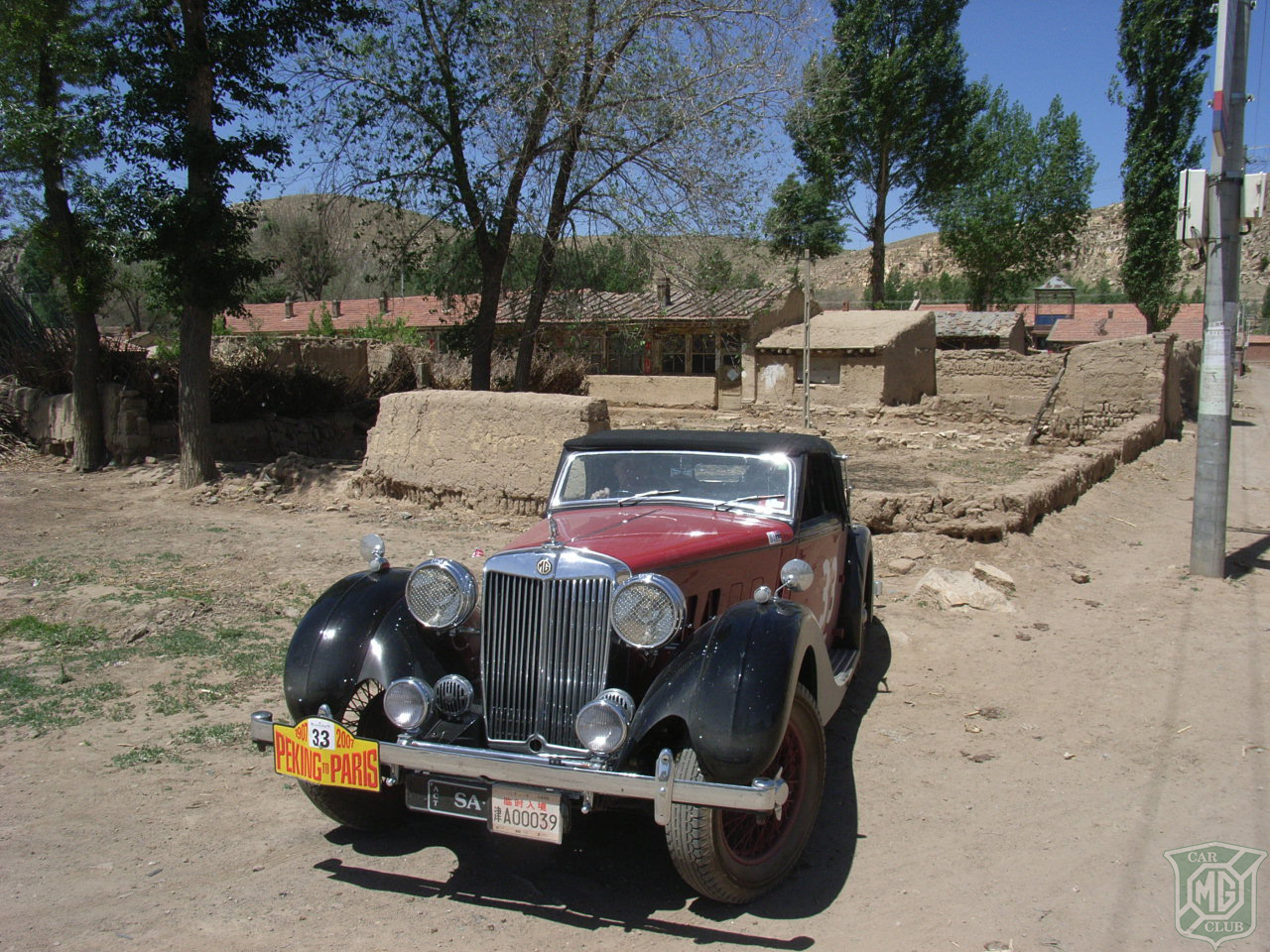
Mongolia
Mongolia is a country of beautiful contrasts, but the roads are the worst gravel tracks in the world. Harry says “In Australia we are used to bad country dirt roads. Take the worst you have ever experienced. Mongolia’s roads are at least twice as bad and then drive across them for thousands of kms within seven days. The pace was relentless if you wanted to keep up and make camp.” When you leave the Border you literally follow the GPS co-ordinates and follow the railway line and telegraph poles to Ulaan Bataar (UB). You arrive onto the gravel as soon as you leave the border.
“We broke the Chassis on the first morning of the Gobi. I believe the damage started in China when without warning a bitumen road came to an abrupt stop in front of not a gravel road but a washed out gully. Somewhere on the other side was the toughest stony road I have driven on for many years. The MG was airborne. Like a long jumper trying to reach the road. But two tonnes of car inevitably hit hard. The front shock absorbers where too stiff and mounted forward to the front of the Chassis, probably reached their full extension with dire results. Cracking the Chassis from the top.” Driving across the Gobi with a broken Chassis meant driving across the virgin Desert, not unlike Prince Borghese would have done 100 years ago. Only here could they escape the gruelling punishment of the corrugated roads.
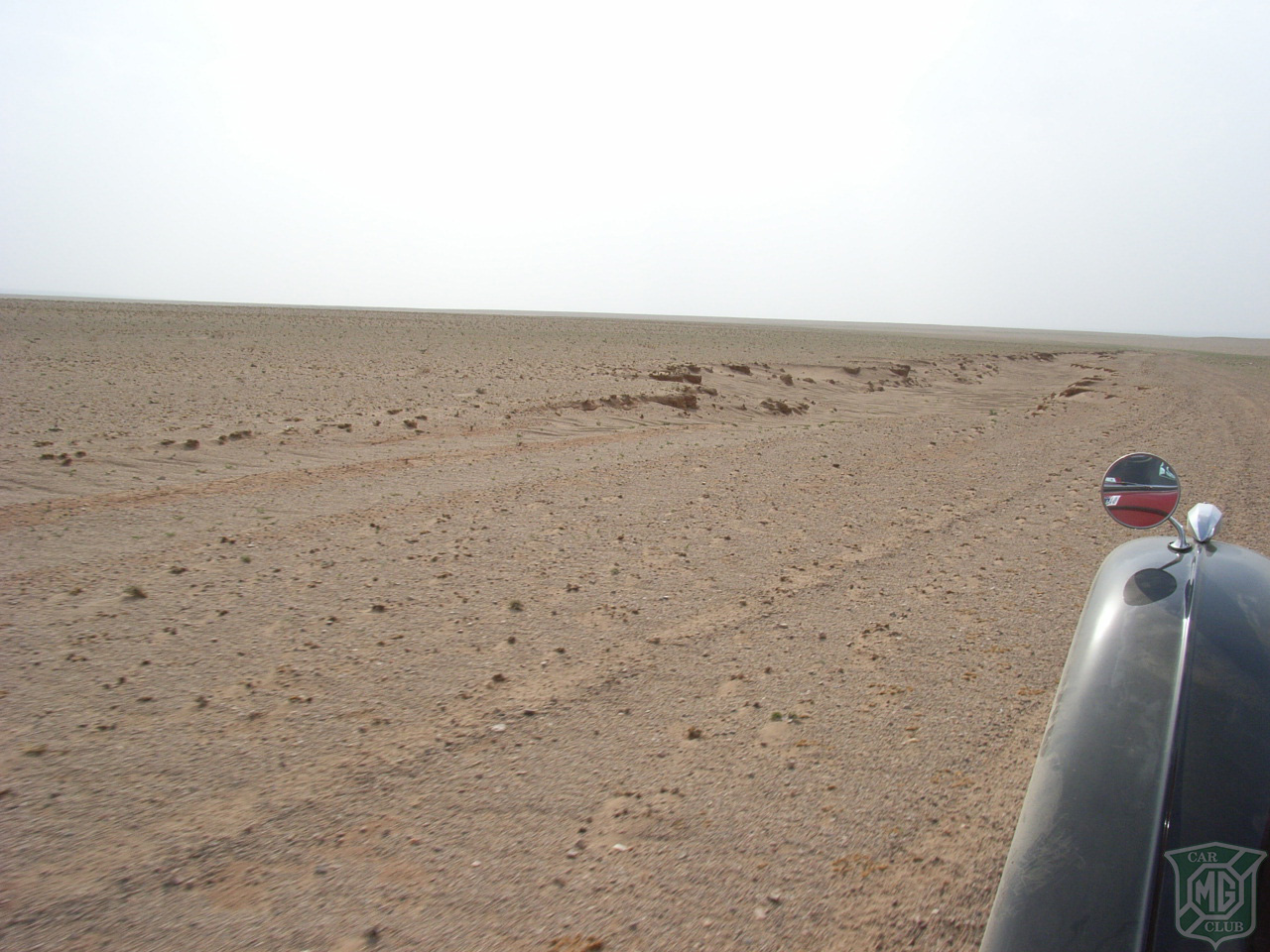
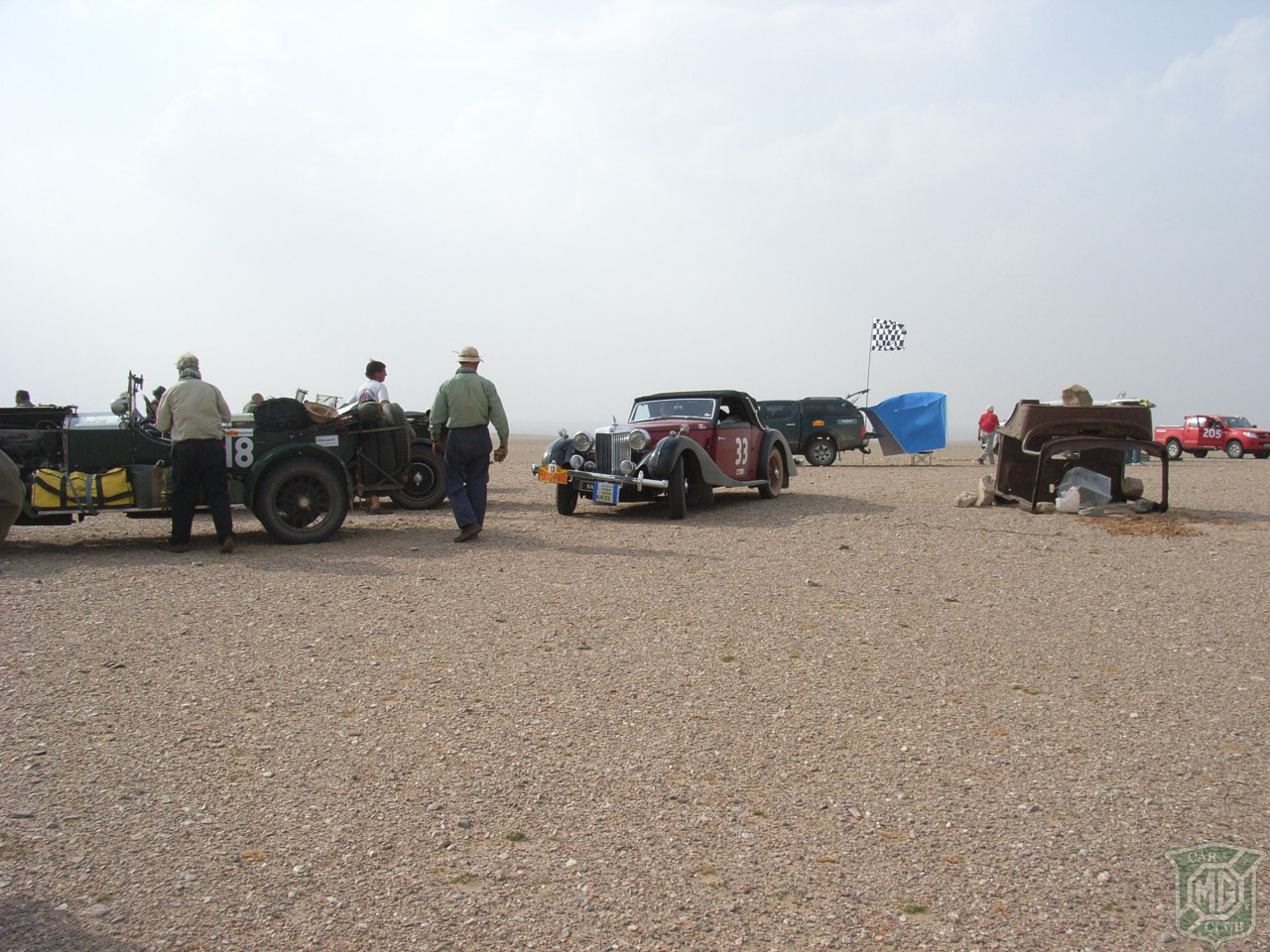
The Rally not only had to contend with the Gobi Desert and rough roads, they had two days of Sand Storms. Cars where lost in the Desert, many stopped as did Harry and Cathy rather than damage the engine by sucking in a lung full of desert sand. “At Sainshand where we stopped on the first night to weld the chassis, I was looking at this Russian tank high up on a ridge looking over the town as a monument to the Cold War. It was a beautiful twilight night with a deep blue sky.
The storm just rolled in and blocked out all visibility. You couldn’t see the house on the other side of the road from the workshop and fuel station. Cathy took shelter in the car, I was in the workshop waiting for our turn in the queue for repairs. The power went out and then it was recommended by the locals that we move the car as the light poles where swaying so vigorously in the wind they felt the car was in danger from their collapse. Of course I moved the car, but I was really more concerned about when we would get power back to repair the chassis!”
The Chassis was eventually repaired, with the whole front suspension removed from the Car. Straightening the front axle would have to wait until Siberia. Proudly, the Australian Flag flew from the Genghis Khan hotel during their visit to UB (PP23). The Hotel would not have it flying from the car on the Hotel forecourt it must be flown at the same level as the Mongolian Flag. Cathy continues: “I believe Australians and Mongolians are sole mates. We both hold a strong value of helping out your mates. Perhaps this is forged by the unforgiving nature of the outback and the Desert. You have to help your mates!” Whenever a car broke down the Mongolians where there to help. When the MG boiled like a Kettle the Mongolians in the middle of the Desert filled the radiator with water.
Unfortunately, the engine side cover plate had worked its way loose under the endless hammering of the corrugations and this was soon repeated, resulting in the blown head gasket. Harry writes for the Rallies upcoming book: “The Best and Worst day of the Rally was the support we got in changing the Head Gasket twice at Altay, working on the car through the night. The worst moment was when we were faced with sending the car home the following morning after everyone had left and we still had water leaking into the sump and mixing with the oil. Fabulously, based on advice from our friend and mechanic Rob Rowe in Australia we tried one last desperate measure of putting Stop Leak into the radiator. At this point water was more precious than fuel and we continued on with our jerry cans full of water. I was sceptical and concerned to be venturing into the Desert like this, but we kept monitoring the situation and kept going. I think it took a couple of days before I really relaxed”
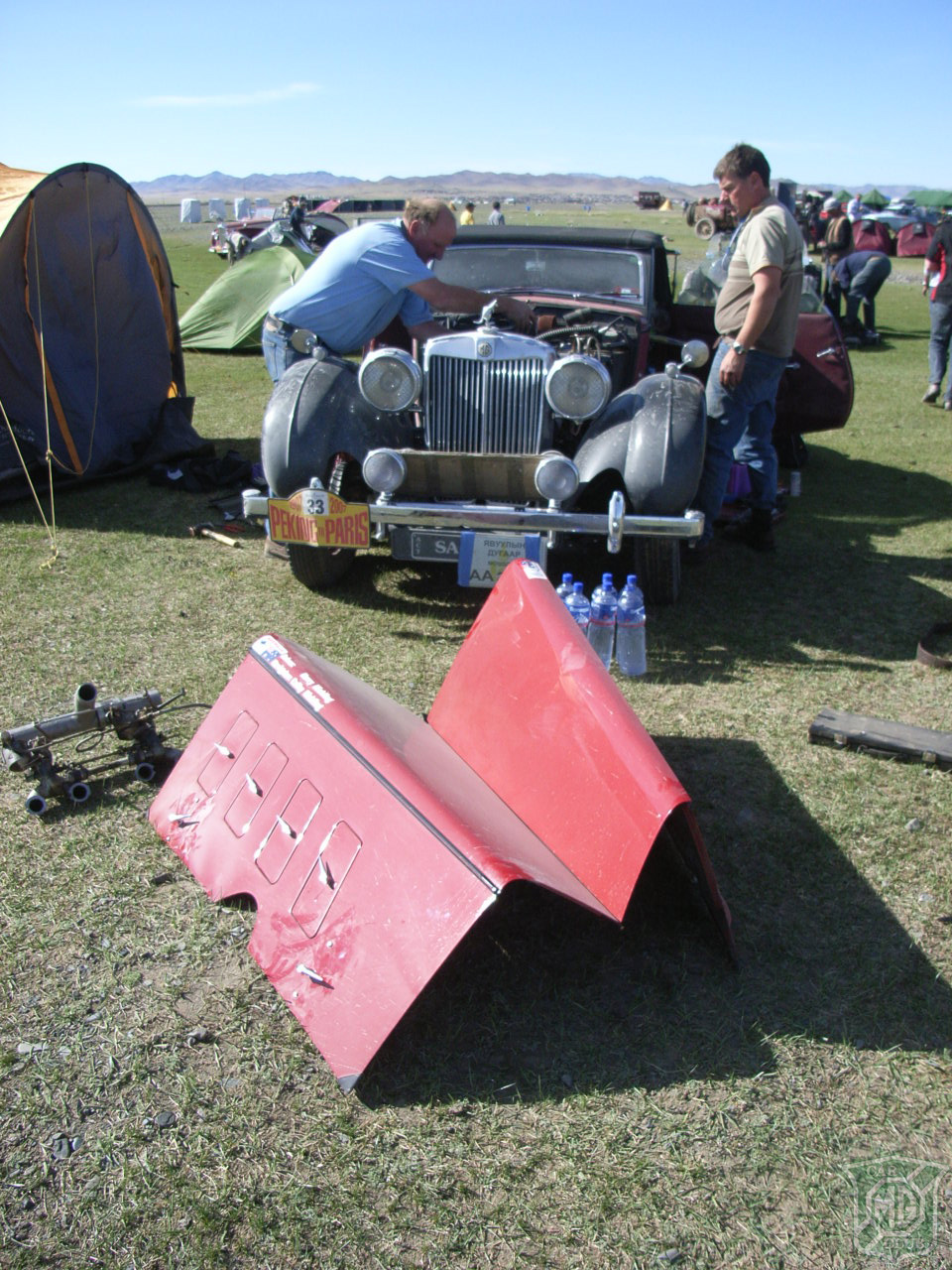
From UB we saw the most arid and spectacular Desert Country on earth. Wide valleys, snow capped mountains and beautiful lakes. It was spectacular. We also crossed several river crossings, a few of which where quite deep. We had prepared for this and the MG had no problems. “We passed several cars with electrical problems after the river crossing, several cars had to be towed out and at least one car ended up with water in the rear axle housing resulting in bearing failure a few days later”.
The roads became real car breakers and not suitable for these pre-war cars. Surely there was an easier route to follow? The corrugations where unbelievable, “they where a foot wide and six inches deep. No matter what speed you where doing they where impossible. For the next four days something would break on the car every day. They where long tiring days crossing the most arid and remote areas on Earth. On the second last night of the Rally in Mongolia only sixty cars made camp. The remainder of the rally was strewn across the Desert or on trucks being either transported back to UB or into Russia”.
Siberia
As desolate that Mongolia is, as you cross the Border you shortly cross the top of the range and enter into the most magnificent river valley with forests and snow capped mountains. This is like a picture from Canada. “We had no appreciation of what Siberia would be like. This has to be one of the worlds best kept secrets. At every town the Russians come out and welcome us. They are overjoyed to see us”. This part of Siberia is a fantastic drive after leaving the roads of Mongolia. Behind us is a convoy of trucks with cars on their way to Novosibirsk in Siberia for repairs.
Russia
Of course the rally can’t continue to be as easy as our day driving through Siberia to Bijisk. The further we travel across Russia the worse the roads are. No longer corrugated gravel roads. We now have to deal with corrugated bitumen roads. Many look like a fleet of over weight trucks drove along the bitumen as soon as it was poured. Like tram tracks they would throw the MG from side to side and if we weren’t careful throw the car off into a paddock or worst still a truck. As a result the carnage and breakdowns continued for the rally. Moscow and St Petersburg are of course real highlights of the trip. We ride the Metro’s and see the Kremlin. We are pulled over by the Police to have our Photo’s taken. Unfortunately many in the rally are pulled over by the Police on the last day and fined what ever money they can get. The corruption in Russia being very evident to us during the final days of the Rally, and then it takes 6 and 1/2 hours to cross the Border. For some cars it takes 8 or 9 hours.
Estonia, the Baltic States and Germany
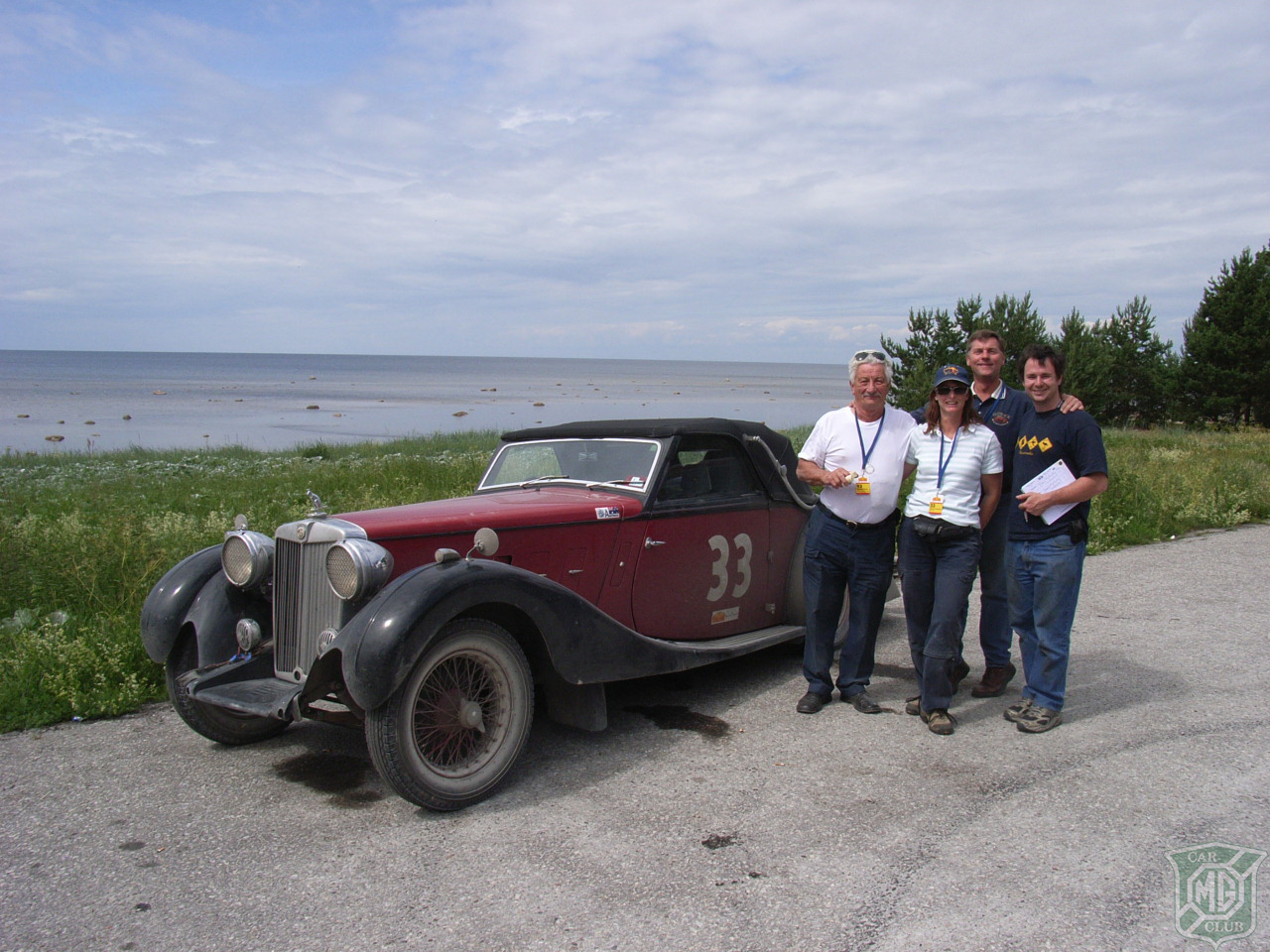
What a surprise. These countries have left communism in their wake and their progress is in stark contrast to the third world country of Russia that we have just driven through. They are picturesque areas and will be the future tourism destination for Europe. In Poland the Lake District is magic and you drive through lush forests and corridors of trees. By now the MG is driving on five cylinders. No 1 Cam Follower has broken in half. Fortunately, we don’t have a broken camshaft, nor did the bottom half fowl the crank shaft as it fell into the sump! We tried to get it fixed, but life isn’t that easy sometimes. This Cam Follower has a specially designed Cap on it for improved MG performance, but impossible to remove without dismantling a third of the engine. It isn’t bad running on the flat roads, but in Europe there are plenty of mountains and especially as we navigate our way through Germany it was slow going pulling two tonnes of MG up the mountain passes.
Paris, France
Well Cathy and Harry made it to Paris for the weekend. “Along the way we saw these countries first hand, meeting the people and making many new friends. We will always remember the welcome that we received by the local people and the mystic Buddha temples and the ancient Mongolian City of Karakorum”.
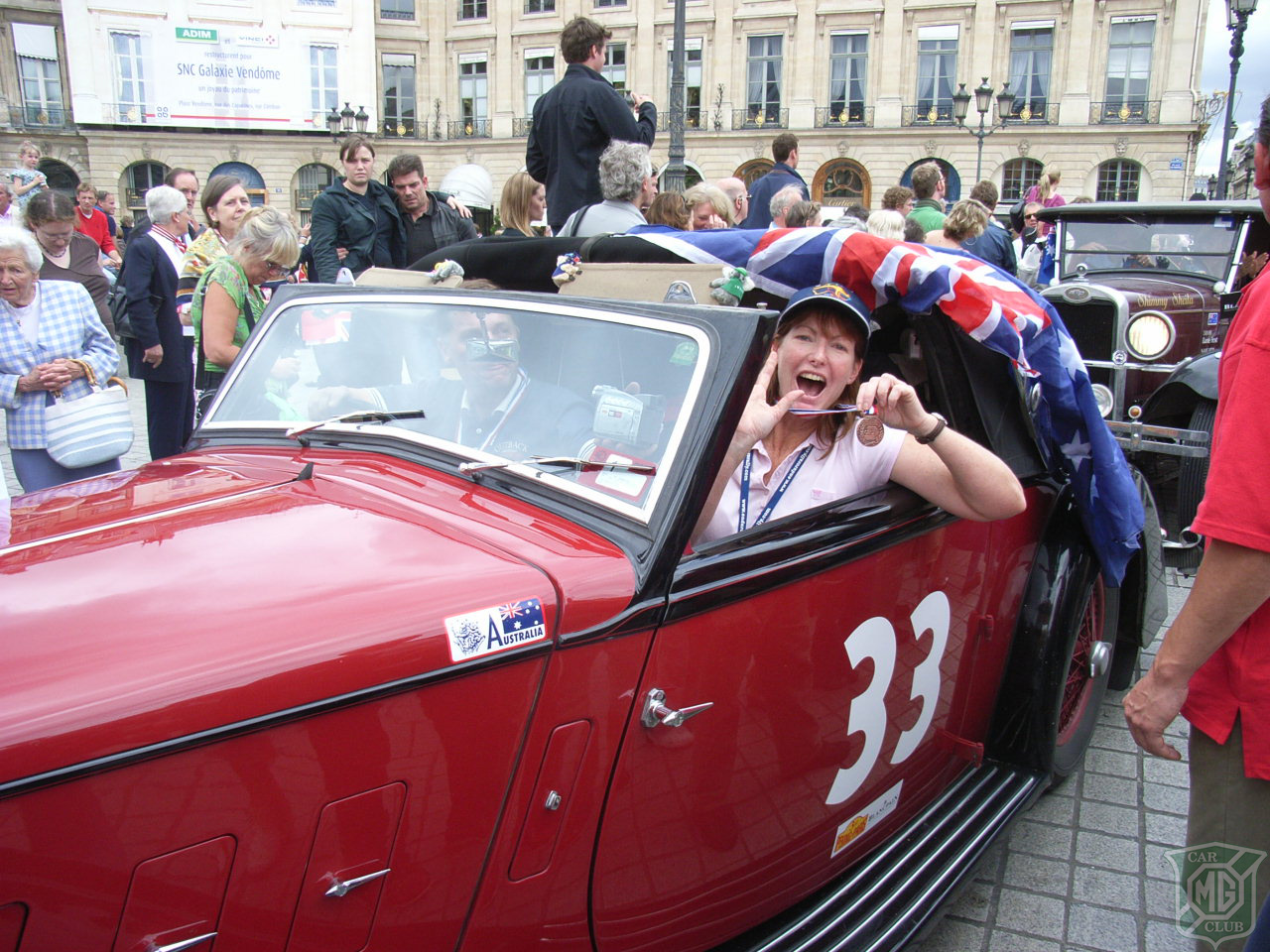
There is no record of which cars and teams actually drove the whole way, but Harry and Cathy believe it was certainly less than half the field. With the nuances of the Rally results even Vintagent cars that actually spent time being shipped on truck finishing ahead of them in the standings at 32nd position overall and 22nd in class. For Harry and Cathy it was always about taking the car of their choice from Peking to Paris. Experiencing in part what those great motoring pioneers had achieved 100 years earlier.
I ask if they will do it again? “Absolutely says Harry. We are already making preparations for the 2010 Rally along the Silk Road from Beijing to Paris.” And yes they still have the remains of the third SA Chassis in the Garage. You know that only 246 of these cars are still in existence! What will Cecil Kimber ever think?

 MG Car Club
MG Car Club